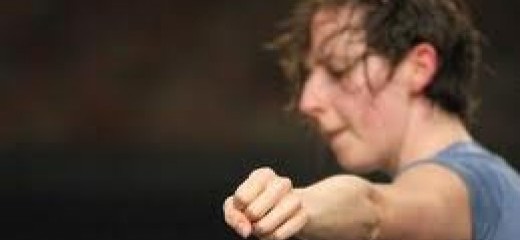
From Gdansk, Warsaw and Burdag: Recasting the Past
by Lisa Kraus
It may be that in Warsaw or Gdansk or Burdag audience members sit rapt as a performer takes the time to vacuum an entire performance space. It does take a while. Or as she runs, backwards, in repeating zig-zags again and again and again, shifting from lateral passes of the space, to diagonals, and finally to down- and upstage lines.
Without the exacting persistence of minimalism, these actions read as “let’s do some of this, then some of that.” Watching Marysia Stoklosa perform them in Vacuum, on a program shared with other visiting Polish artists, I felt thrown back to the earliest investigations of the Judson Dance Theater’s evenings fifty years ago. In Philadelphia in 2012, I asked myself “what questions is this kind of work posing now?”
Stoklosa, Izabella Chlewinska and Magda Jedra , the three artists taking part in an exchange between Dance/USA Philadelphia and Art Stations Foundation in Poznan seem to be investigating time, structure, the use of pedestrian activity and themes of violence and oppression. They are compelling performers with highly articulate physicalities. They investigate falling, stop-action, repetition and contortion. They are flexible, forceful, focused and sometimes highly inventive. They don’t appear to be concerned with “development” in any conventional sense.
Chlewinska’s initial act is writing a series of phrases on large sheets of paper. After the phrase “where time folds into,” she draws a spiral. And then the word “or.” And then an infinity sign. Implied are questions, either/or possibilities, a sense of dimensionality. Her fragmented odalisque poses are charming. Her actions are broken down in Muybridge-like sections. She becomes a peculiar creature in yoga’s wheel pose (the one where you press hands and feet into the floor to form an extreme backward arch), lifting her limbs, crablike, to locomote. Even though this first piece of the evening shares the same episodic, non-sequitor form as the following two, it contains some loops. Returns create a mysterious through line. Even a Mozart aria is looped into a circling one-liner.
How then does the fact of being of different cultures affect our reading of the work overall? The compositional approach that says anything can go next to anything else is, in the U.S. at any rate, a Judson inheritance. But in the remaining two works using this convention, this viewer felt shortchanged where the artists deliver material in a mode that was quite blank (perhaps an extreme nod to Rainer’s “no to spectacle” manifesto), or cut it off before it was fully developed. There is no doubt much reasoning underlying the acts we are shown, but how might it read more fully through the performing itself? Why do the performers seem stingy, holding tight to their material, their concepts, their seriousness of intent?
When Magda Jedra wraps herself in multiple layers of clothing, takes a box cutter, and slashes through her white outer shirt into her red second layer, there’s a violent implication that begs for illumination. Likewise, when she binds her own ankles and wrists, imprisoning herself, and then staggers across the space (on repeating diagonals) only to fall each time, I wonder how this other intimation of violence and oppression should be read. But she simply drops her action in both instances and goes on to the next move. Is it reasonable to present this kind of material in list fashion? Are we watchers being asked to desensitize ourselves to it? Why is my experience as a viewer one of frustration, of interruptus?
John Cage, whose centennial is being celebrated this year is to thank (or blame, depending on your point of view) for the American iteration of the kinds of ideas in these performers’ works. His dictum—that if something is boring, one should do it for twice as long—definitely applies to events in nature or chance circumstance. But is the attempt at illuminating time in a performance by asking an audience to witness a pedestrian activity like vacuuming so relevant today? The implication is that when you look deeper, nothing is boring. But bored isn’t what I felt. I felt that these performers could show us so much more, so should I not say that it felt like being deprived?
It was Cage too who got us placing unrelated materials side by side, without concern for how they “work” together. But careful thought for dramaturgy in using charged imagery is warranted today. Is this cultural too? Is it just an option to be responsible to the totality of what is created?
Of course, not being of the culture of these young artists may mean that my eyes are simply unable to perceive their work as it is intended. Can young artists be held responsible for integrating a history that happened on a different continent decades before? What does it matter if they repeat some of it? Perhaps the answer is “it doesn’t.”
Personally though, if it’s not done in such a way that the work is, in Deborah Hay’s words, “inviting being seen,” I don’t necessarily want to be around to watch.
Solos from Gdansk, Burdag and Warszawa by Polish Exchange Artists, Sept. 14-16, 8pm, Mascher Space Co-op.
By Lisa Kraus
September 16, 2012

